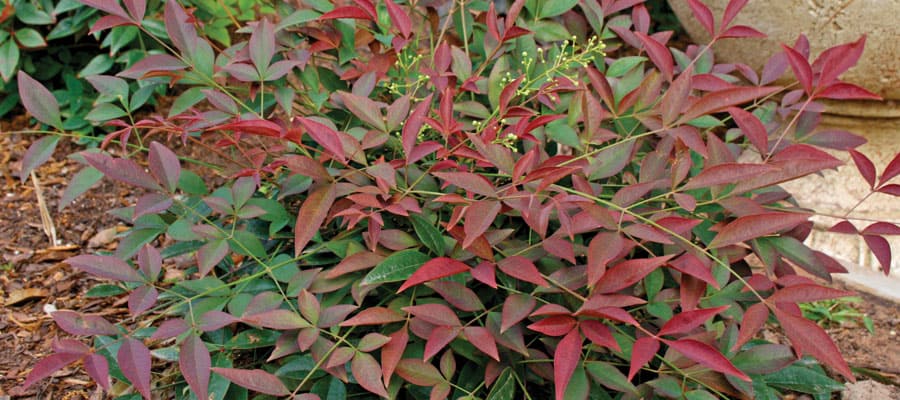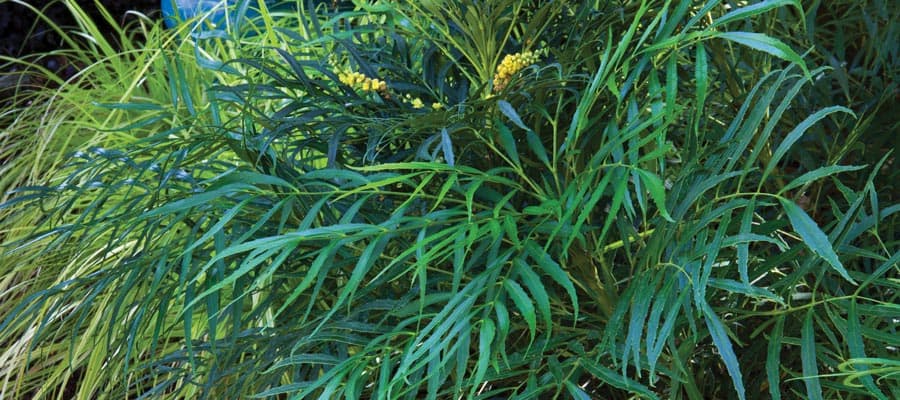By Johanna Silver, Sunset Magazine
Find more curb appeal inspiration here.
There are better ways to save water besides letting the lawn go brown.
At the height of California’s drought, Sue Smith and Georganne Rosenberger did everything they could think of to save water at their Albany , California , home—including letting their front lawn die. “It was the zeitgeist,” says Smith . “Everyone was doing it.” But last year, tired of the grim landscape, they enlisted the help of garden designer Rebecca Sweet (harmonyinthegarden.com). As they learned from Sweet, simply letting a lawn die—however well intentioned—isn’t actually the most sustainable choice. “Established trees, bees, and birds all suffer,” says Sweet . “Having a low-water garden helps the ecosystem survive a drought.” To bring lushness to Smith and Rosenberger’s yard, Sweet clustered large swaths of plants in jewel tones that echo the home’s colors . Though nearly all of the plants are low-water once established, the designer took a multipronged approach to save every drop possible, from installing a drip-irrigation system that operates on a smart timer to placing a rain barrel under a downspout to catch runoff . (Even though droughts ebb and flow in the West, California is still a summer-dry climate, making a water-wise garden a smart idea regardless of winter rainfall.) Half a year later, Smith and Rosenberger couldn’t be happier with the garden as it has grown in. “We sit in the living room and stare out the window in complete disbelief that this is ours,” says Smith. And when they open their water bill each month, they’re equally shocked: The amount hasn’t budged.
The Plan

Sweet’s plants came exclusively from the Sunset Western Garden Collection, chosen for low-water and low-maintenance merits. Find a retailer near you.

A. EverColor® ‘Everillo’ Carex: Shade to part sun; 12–18 inches tall and wide; hardy to –20°. This ornamental grass is bright chartreuse, making it your best bet for brightening up a shaded spot.

B. Purple Diamond® Semi-dwarf Loropetalum: Part sun to shade; 3–4 feet tall and wide; hardy to 0°. Bright pink flowers in spring give way to year-round purple foliage.

C. Chef’s Choice® Rosemary: Full sun; 12–18 inches tall and wide; hardy to –10°. This is the only rosemary you’ll ever need, with a beautiful form and high oil content.

D. Platinum Beauty™ Lomandra: Full sun to part shade; 2–3 feet tall and wide; hardy to 15°. This grasslike perennial offers year-round fountains of white and green stripes.

E. ‘Beyond Blue’ Festuca: Full sun, 12 inches tall and 18 inches wide, hardy to –25°. Perfect for border edges, this ornamental grass stays vibrant blue even in summer heat.

F. ‘Amistad’ Salvia: Full sun to part shade; 3–5 feet tall by 3–4 feet wide; hardy to 18°. Deep purple flowers bloom year round in frostfree climates and need no deadheading.

G. ‘Lemon Lime’ Nandina: Full sun to part shade, 3–4 feet tall and wide; hardy to –10°. Tuck this lime and dark green version of the familiar nandina into shaded corners everywhere.

H. Purple Pixie® Dwarf Weeping Loropetalum: Part sun to shade; 1 foot tall by 4–5 feet wide; hardy to 0°. The only weeping Loropetalum, this plant offers purple foliage all year.

I. Flirt™ Nandina: Full sun to part shade; 1–2 feet tall and wide; hardy to –10°. New growth on this shrubby perennial emerges red and retains its color all summer long.
J. Echeveria imbricata: Sun or shade, 4–6 inches tall and wide; hardy to 25°. This vigorous succulent has tight rosettes of flat gray-green leaves.

K. ‘Love and Wishes’ Salvia: Full sun to part shade, 3–4 feet tall by 3 feet wide; hardy to 25.° Just a touch more petite than ‘Amistad’, this plant has the same year-round purple blooms in frostfree climates.

L. Illumination® ‘Apricot’ Digiplexis®: Full coastal sun to part shade in hotter climates; 3 feet tall and 11/2 feet wide; hardy to 15°. From spring through fall, this plant cranks out long stalks of foxglove-like pink and orange blooms. Prune dead flower stalks to keep blossoms coming.

M. ‘Diamond Heights’ Ceanothus: Shade to part sun; 1 foot tall by 4–5 feet wide; hardy to 20°. Bright foliage plus pale blue flowers in the spring make this West Coast native groundcover an all-star.

N. ‘Ember’s Wish’ Salvia: Full sun to part shade; 3–4 feet tall by 3 feet wide; hardy to 25°. Coral flowers need no deadheading and bloom year round in frost-free climates. A portion of plant proceeds goes to Make-A-Wish.

O. ‘Meerlo’ Lavender: Full sun to part shade, 2 feet tall and wide, hardy to 23°. Plant this brightly variegated lavender where you can brush up often against its scented leaves.

P. ‘Sunshine’ Ligustrum: Full sun; 3–6 feet tall by 3–4 feet wide, hardy to –10°. Unlike typical Ligustrum (privet), this bright chartreuse version has a tidy form and isn’t invasive.

Q. ‘Soft Caress’ Mahonia: Part sun to shade; 3 feet tall and wide; hardy to 5°. This mahonia without the thorns makes a nice textural addition to a shade garden.

R. Black Adder Phormium: Full sun to part shade; 3 feet tall and wide; hardy to 15°. The dark burgundy foliage acts as a focal point the entire year.

